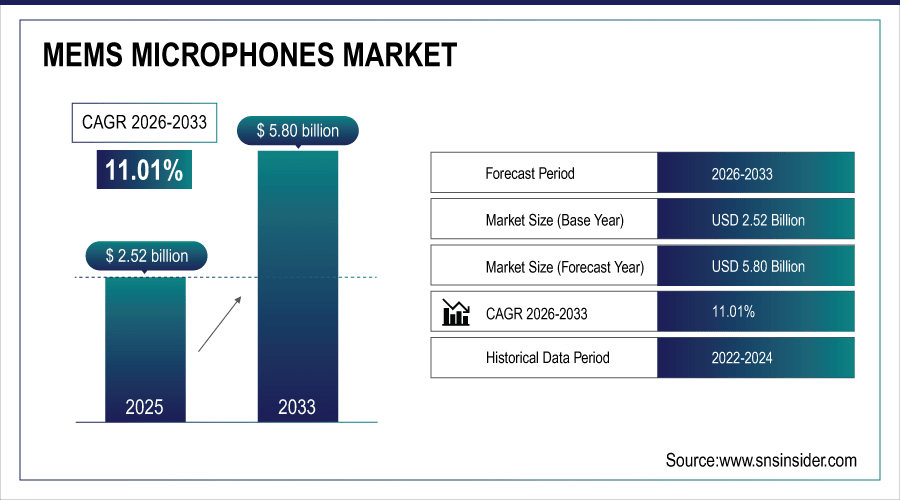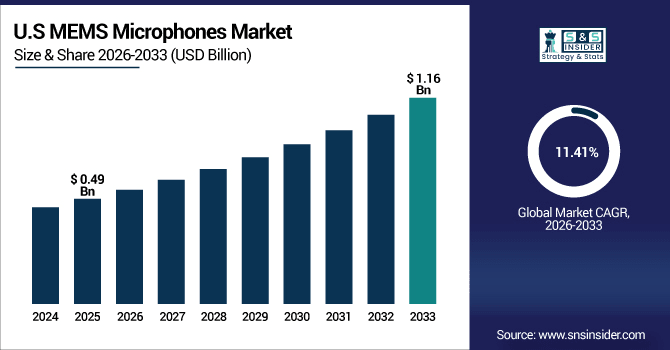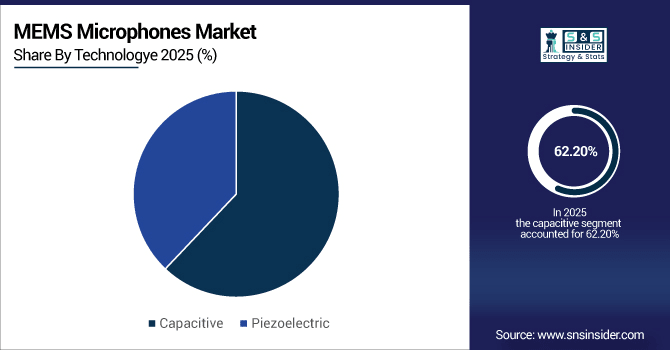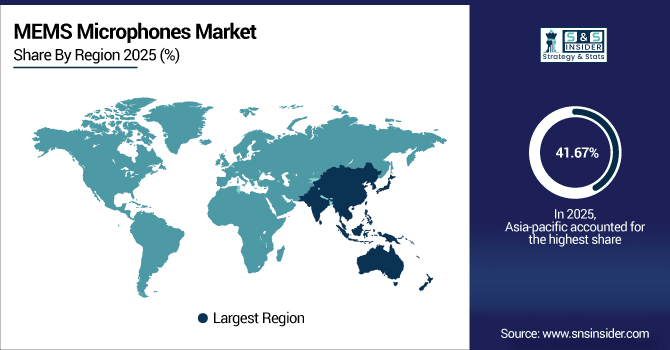MEMS Microphones Market Size & Growth:
The MEMS Microphones Market size was valued at USD 2.52 Billion in 2025E and is projected to reach USD 5.80 Billion by 2033, growing at a CAGR of 11.01% during 2026-2033.
The MEMS Microphones Market is expanding due to the rising penetration of smart devices such as smartphones and hearing aids, need for high-performance acoustic systems for miniaturized portable devices, and increased voice control–based smart products. Evolution in automotive applications, such as voice-controlled infotainment systems and advance driver-assistance system, has significantly increased the market demand. Advanced functionalities like high SNR and enhanced product performance is the result of technologies like multi-microphone arrays and noise-cancellation.
85.1% and 50.0% of premium and mid-tier smartphones in 2024 respectively adopt at least 2 MEMS microphones for beamforming and noise suppression, as AI voice assistant use cases including smart speakers are deployed in over 4.2 billion active devices worldwide. MEMS mic adoption in hearing aids jumped 35% YoY, with now 90% of new digital hearing aids using our ultra-low-noise variants, ensuring more reliable speech recognition.

To Get More Information On MEMS Microphones Market - Request Free Sample Report
Market Size and Forecast:
-
Market Size in 2025: USD 2.52 Billion
-
Market Size by 2033: USD 5.80 Billion
-
CAGR: 11.01% from 2026 to 2033
-
Base Year: 2025
-
Forecast Period: 2026–2033
-
Historical Data: 2022–2024
MEMS Microphones Market Trends
-
MEMS microphones are becoming smaller and more integrated, and capable of fitting into compact products such as wearables, ear-wear devices (earbuds) and smartphones without sacrificing performance.
-
‘Increasing demand for high-performance MEMS microphone with precise voice capture quality due to growing usage of voice assistants, smart speakers, and IoT linked devices’
-
MEMS microphones are gaining momentum in car voice-controlled infotainment systems and hands-free applications for noise cancellation, marking growth convergence with advanced automotive electronic applications.
-
Signal to Noise ratio, multi-microphone array and noise suppression technologies are improving the quality of audio (high fidelity sound capture and rendering for premium) fulfilling consumers’ needs & dream to hear their favorite artist in studio/master quality.
-
Better manufacturing processes and more efficient economies of scale have brought MEMS microphone prices down, making them viable options across consumer electronics, healthcare products and industrial applications.
The U.S. MEMS Microphones Market size was valued at USD 0.49 Billion in 2025E and is projected to reach USD 1.16 Billion by 2033, growing at a CAGR of 11.41% during 2026-2033. MEMS Microphones Market growth is driven by rapid growth, owing to the increasing use of smartphones, smart speakers and wearables which require high-quality, compact audio components. Rapid proliferation of voice-controlled systems and IoT-connected smart home devices is also augmenting demand. Automotive is also contributing, with MEMS microphones in infotainment systems, hands free communication and noise cancellation.

MEMS Microphones Market Growth Drivers:
-
Rapid Adoption of Smart Devices and Automotive Systems Boosting MEMS Microphones Market Growth.
Advancing requirements for highly compact advanced audio solutions in smartphones, wearables and smart home devices are fueling the MEMS microphones market. Adoption is driven, in turn, by the proliferation of voice-controlled systems, virtual assistants and IoT integration. Within automotive, MEMS microphones are widely employed in the infotainment system, in hands-free calls and active noise cancellation. Audio quality is benefiting from technological developments such as multi microphone arrays and better signal to noise ratios, while production costs are falling and the trend towards miniaturization favours MEMS microphones – all factors that are supporting strong industry growth.
Automotive infotainment systems in 65% of new vehicles now integrate MEMS mics for hands-free calling and ANC, with cabin mic counts rising to 3–6 per vehicle to support voice AI and occupant sensing.
MEMS Microphones Market Restraints:
-
High Manufacturing Costs and Technical Challenges Limiting MEMS Microphones Market Penetration in Certain Segments
Despite its positive thrust, the MEMS microphones market is being countered by initial high costs of manufacturing and fabrication complexities. Issues integrating higher-level audio functions, like noise suppression and multi-mic arrays, lead to longer development times and higher costs. Furthermore, competing technologies including electret capsules alongside conventional capacitor microphone placement may delay uptake in cost-sensitive market sectors. Supply chain interruptions and reliance on specialty materials required for Micro-Electro-Mechanical System (MEMS) manufacturing further inhibit scale, constraining market access in developing markets and smaller footprint consumer electronics.
MEMS Microphones Market Opportunities:
-
Expansion in Automotive, Wearable, and IoT Markets Presenting Significant Growth Opportunities for MEMS Microphones
Automotive, wearables and IoT connected smart devices drive the MEMS microphones market. Rapid growth in voice-controlled infotainment systems, smart assistants and home-automation solutions is boosting demand for high-performance miniaturized microphones. Additional upside potential lies in the emerging markets that are adopting smartphones and smart devices. Advances in multi-microphone arrays, noise cancelling, and high signal-to-noise ratio enable new opportunities for product differentiation.
In 2024, automotive MEMS mic shipments grew 45% YoY, with 75% of new connected cars featuring voice-controlled infotainment and 50% supporting multi-zone voice assistants via 4+ mic arrays.
MEMS Microphones Market Segment Analysis
-
By technology, capacitive MEMS microphones led the market with a 60.20% share in 2025, while piezoelectric microphones are the fastest-growing segment with a CAGR of 8.10%.
-
By application, mobile phones dominated the market with a 46.50% share in 2025, whereas IoT and VR applications are growing the fastest at a CAGR of 9.40%.
-
By type, dialog MEMS microphones held the largest share at 58.70% in 2025, while analog microphones are the fastest-growing type with a CAGR of 8.60%.
-
By signal-to-noise ratio (SNR), very high (≥64dB) microphones accounted for 44.90% of the market in 2025, while high (≥60dB, <64dB) microphones are the fastest-growing segment with a CAGR of 9.10%.
By Technology, Capacitive Leads Market While Piezoelectric Registers Fastest Growth
The capacitive technology dominates the MEMS microphones market due to its reliability, which is likely to be adopted by consumer electronics, whereas resistive ones have only limited applications, as they are less sensitive in nature. Capacitive microphones have the advantages of high sound precision, low noise and can be adapted to smartphones, wearable devices and automotive systems. On the other hand, piezoelectric MEMS microphones are witnessing highest growth on account of their extreme environmental resistance providing longer durability as well as being potential for military & defense, industrial and automotive and specialty audio applications.

By Application, Mobile Phones Dominate While IoT & VR Shows Rapid Growth
Mobile phones are still the largest application market for MEMS microphones, as they need mini-size and high-performance microphones for long time voice call, video recording, noise cancellation. This demand is in response to the worldwide spread of smartphones and customers' heightened expectation for better sound quality. In the mean time, IoT devices, virtual reality (VR), and smart home systems are growing faster. Such segments need speakers and microphones for voice commands, immersive audio, environment sounds detection etc making it as very promising markets.
By Type, Dialog Lead While Analog Registers Fastest Growth
Dialog MEMS microphones are the current market leader when it comes to voice capture performance, noise suppression and integration in mobile and smart devices. Their proliferation is motivated by the stringent need for high fidelity audio in consumer electronics, automotive and communication devices. On the other hand, analogue MEMS microphones are rapidly growing driven by lower price, integration capability of existing circuits and applicable to emerging IoT Wearable Industrial applications which is appealing more to manufacturing companies.
By SNR, Very High (>=64dB) Lead While High (>=60dB, <64dB) Grow Fastest
Very high signal-to-noise ratio MEMS microphones (≥64dB) is leading the market as they provide higher sound clarity and precision, which is required for smartphones, professional audio equipment and automotive infotainment. These microphones can accurately pick up sound even in the midst of boisterous settings, providing users with an improved overall experience. At the same time, however, high SNR microphones (≥60 dB and <64 dB) are growing most rapidly since they provide a good mix of performance and value that's suited for wearables, smart home devices, IoT gadgets and lower-cost consumer devices.
Asia-pacific MEMS Microphones Market Insights
In 2025E Asia-Pacific dominated the MEMS Microphones Market and accounted for 41.67% of revenue share, this leadership is due to high penetration of smartphones, high adoption of smart devices, and growth in consumer electronics manufacturing. Production and innovation in countries like China, Japan and South Korea are major hubs. The growing popularity of IoT equipment, wearables and automotive electronics is also boosting market expansion. Technological progress is fostered through R&D investment and supportive policies from the government.

Get Customized Report as Per Your Business Requirement - Enquiry Now
China MEMS Microphones Market Insights
China is a key market due to the large production base, and high consumption of smartphones and smart devices in the country. The nation also is the beneficiary of long supply chains and sophisticated semiconductor fab facilities. Adoption grows at an accelerated pace due to the adoption of IoT, smart home devices, and voice-enabled devices.
North America MEMS Microphones Market Insights
North America is expected to witness the fastest growth in the MEMS Microphones Market over 2026-2033, with a projected CAGR of 11.82% due to increased use in smartphones, wearables and smart home applications. It is the largest market and has a strong demand with advanced automotive applications and voice-controlled systems driving growth. Market Growth Factors Scenarios Market growth factors such as infusion smart pumps with wireless connectivity (technological advancements), presence of key manufacturers and supporting infrastructure drive the market growth.
U.S. MEMS Microphones Market Insights
The U.S. is a significant market for MEMS microphones, with high penetration of Smartphones, wearables and other smart home devices. Factors like voice-controlled systems, virtual assistants and IoT integration are also contributors to its growth. Automotive services, such as infotainment and active noise cancellation, also underpin demand.
Europe MEMS Microphones Market Insights
Europe is propelled by the automotive, industrial and consumer electronics industries. Market facts in Germany, which adds up considerably on account of high automotive manufacturing and voice-enabled systems. Demand is also driven by smart home devices, IoT applications and professional audio equipment. The area is well supported with excellent production standards, R&D infrastructure and innovation in miniaturisation and noise-cancelling.
Germany MEMS Microphones Market Insights
Germany has the largest market for MEMS microphones is Europe, Germany has very well established automobile sector which prioritize on voice enabled in-car howling system. Industrial IoT and professional audio equipment also help. For Germany manufacturers, they emphasize the high quality and reliability of energy-efficient MEMS Microphones for domestic and export markets.
Latin America (LATAM) and Middle East & Africa (MEA) MEMS Microphones Market Insights
The MEMS Microphones Market is experiencing moderate growth in the Latin America (LATAM) and Middle East & Africa (MEA) regions, due to the rising smart phone proliferation along with growing disposable income that has led to surge in consumer electronics industry. The popularity of IoT devices, automotive initiatives and smart homes in metropolitan areas are also driving demand. It has a relatively small market size but investments are rising from international manufacturers. New prospects are opening up through technological awareness and infrastructure improvement.
MEMS Microphones Market Competitive Landscape:
AAC Technologies is a leading manufacturer of MEMS microphones for smartphone, wearable and automotive applications. With a strong global presence and R&D capability, ADI have focused on innovation, advanced miniaturized and high SNR RF components.
-
In August 2025, AAC Technologies projected over 50% revenue growth in MEMS microphones, driven by AI applications. The company also launched a 2.0 mm x 1.5 mm MEMS microphone module, among the smallest commercially available, enabling thinner TWS earbud designs without sacrificing acoustic performance.
CUI Devices offers high sensitivity, low noise MEMS microphones for consumer electronics, industrial and automotive applications. Its dedication to cost-effective solutions and product flexibility contributes greatly in the capturing of emerging markets as well as expanding home automation and smooth deployment on smart gadgets/ IoT.
-
In September 2024, Same Sky (formerly CUI Devices) introduced new MEMS microphones featuring high signal-to-noise ratios (SNR) of 62dBA or 64dBA and high acoustic overload points (AOP) of 123dB or 128dB SPL.
Goertek is a leading MEMS microphone producer, providing high-end acoustic devices for smartphone, smart speaker and automotive electronics markets. The company pours resources into R&D so as to develop high-performance, mute, brat small-size microphones for its global strategy.
-
In July 2023, Goertek released a combination MEMS microphone/pressure sensor based on Infineon Technologies' die, with multiple controllers embedded in the substrate. This development aims to provide integrated solutions for applications requiring both audio capture and pressure sensing, enhancing the functionality of devices in various consumer electronics.
MEMS Microphones Companies are:
-
CUI Devices
-
DB Unlimited, LLC.
-
Goertek
-
Infineon Technologies AG
-
Knowles Electronics, LLC.
-
Nisshinbo Micro Devices Inc. (New Japan Radio Co.)
-
Projects Unlimited Inc.
-
Sonion
-
STMicroelectronics
-
Qualcomm Technologies, Inc. (Vesper Technologies, Inc.)
-
Analog Devices, Inc.
-
Bosch Sensortec GmbH
-
Cirrus Logic, Inc.
-
TDK Corporation (InvenSense MEMS)
-
Hosiden Corporation
-
ON Semiconductor
-
Omron Corporation
-
Sennheiser electronic GmbH & Co. KG
| Report Attributes | Details |
|---|---|
| Market Size in 2025 | USD 2.52 Billion |
| Market Size by 2033 | USD 5.80 Billion |
| CAGR | CAGR of 11.01% From 2026 to 2033 |
| Base Year | 2025E |
| Forecast Period | 2026-2033 |
| Historical Data | 2022-2024 |
| Report Scope & Coverage | Market Size, Segments Analysis, Competitive Landscape, Regional Analysis, DROC & SWOT Analysis, Forecast Outlook |
| Key Segments | • By Technology (Capacitive and Piezoelectric) • By Application (Mobile Phones, Consumer, Electronics, IoT & VR, Hearing Aids and Others) • By Type (Dialog and Analog) • By SNR (Very High (>=64dB), High (>=60dB, <64dB) and Low (<=59 dB)) |
| Regional Analysis/Coverage | North America (US, Canada), Europe (Germany, UK, France, Italy, Spain, Russia, Poland, Rest of Europe), Asia Pacific (China, India, Japan, South Korea, Australia, ASEAN Countries, Rest of Asia Pacific), Middle East & Africa (UAE, Saudi Arabia, Qatar, South Africa, Rest of Middle East & Africa), Latin America (Brazil, Argentina, Mexico, Colombia, Rest of Latin America). |
| Company Profiles | AAC Technologies, CUI Devices, DB Unlimited, LLC., Goertek, Infineon Technologies AG, InvenSense, Knowles Electronics, LLC., Nisshinbo Micro Devices Inc. (New Japan Radio Co.), Projects Unlimited Inc., Sonion, STMicroelectronics, Qualcomm Technologies, Inc. (Vesper Technologies, Inc.), Analog Devices, Inc., Bosch Sensortec GmbH, Cirrus Logic, Inc., TDK Corporation (InvenSense MEMS), Hosiden Corporation, ON Semiconductor, Omron Corporation, Sennheiser electronic GmbH & Co. KG |

